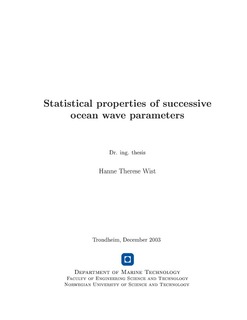| dc.description.abstract | For random waves the free surface elevation can be described by a number of individual wave parameters. The main objective of this work has been to study the statistical properties of individual parameters in successive waves; the wave crest height, the wave height and the wave period.
In severe sea states the wave crest heights exhibit a nonlinear behavior, which must be reflected in the models. An existing marginal distribution that uses second order Stokes-type nonlinearity is transformed to a two-dimensional distribution by use of the two–dimensional Rayleigh distribution. This model only includes sum frequency effects. A two-dimensional distribution is also established by transforming a second order model including both sum and different frequency effects. Both models are based on the narrow-band assumption, and the effect of finite water depth is included. A parametric wave crest height distribution proposed by Forristall (2000) has been extended to two dimensions by transformation of the two-dimensional Weibull distribution.
Two successive wave heights are modeled by a Gaussian copula, which is referred to as the Nataf model. Results with two initial distributions for the transformation are presented, the Næss (1985) model and a two-parameter Weibull distribution, where the latter is in best agreement with data. The results are compared with existing models. The Nataf model has also been used for modeling three successive wave heights. Results show that the Nataf transformation of three successive wave heights can be approximated by a first order autoregression model. This means that the distribution of the wave height given the previous wave height is independent of the wave heights prior to the previous wave height. The simulation of successive wave heights can be done directly without simulating the time series of the complete surface elevation.
Successive wave periods are modeled with the Nataf transformation by using a two-parameter Weibull distribution and a generalized Gamma distribution as the initial distribution, where the latter is in best agreement with data. Results for the marginal and two-dimensional distributions are compared with existing models. In practical applications, it is often of interest to consider successive wave periods with corresponding wave heights exceeding a certain threshold. Results show that the distribution for successive wave periods when the corresponding wave heights exceed the root-mean-square value of the wave heights can be approximated by a multivariate Gaussian distribution. When comparing the results with data, a long time series is needed in order to obtain enough data cases. Results for three successive wave periods are also presented.
The models are compared with field data from the Draupner field and the Japan Sea, and with laboratory data from experiments at HR Wallingford. In addition, data from numerical simulations based on second order wave theory, including both sum and frequency effects, are included. | nb_NO |
